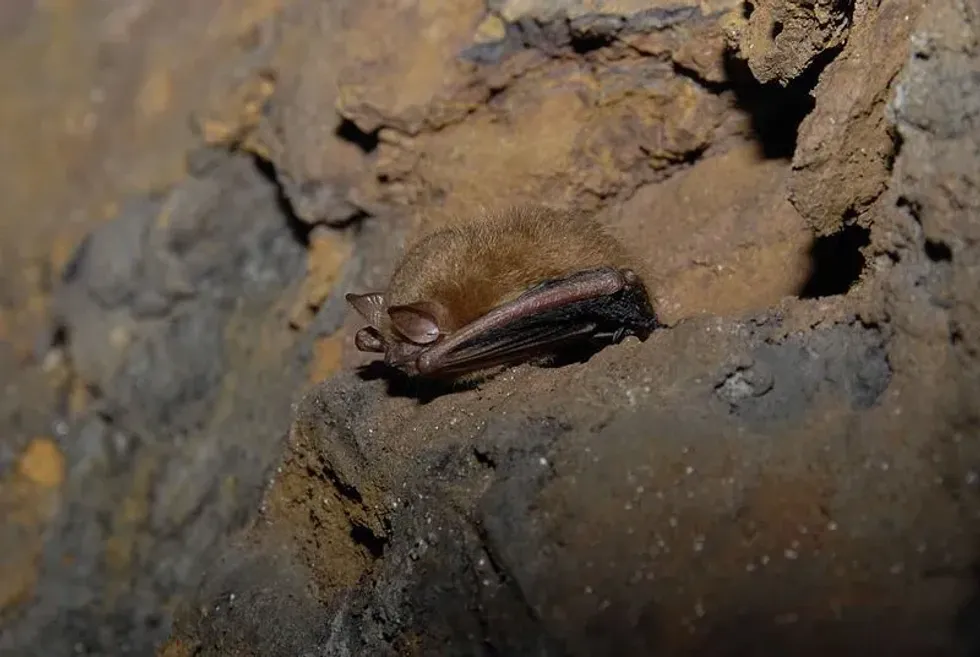Silver-haired bats are medium-sized bat species belonging to the family Vespertilionidae. They are dark brown or grayish-black in color with dark wings and equally dark tail membrane. They prefer to build their home inside small tree hollows, rock crevices, wood-piles, and tree hollows beneath the dense vegetation.
They feed on small insects like crickets, moths, and mosquitoes. Even after belonging to the species of nocturnal creatures, these vertebrates have very poor vision and can see appropriately only in splendid light.
In this way, they utilize the process of echolocation (natural sonar) to comprehend their environment and to catch prey in dim light. Also, this species of bats are much hairier than the other species of bats found commonly in the ecosystem.
Look at these interesting facts about the silver-haired bat and for more relatable content, check out our fact files on fruit bat and ghost bat.
Silver-Haired Bat Interesting Facts
What type of animal is a silver-haired bat?
The silver-haired bat (Lasionycteris noctivagans) is a species of vesper bat, commonly found in the United States and Canada and is otherwise called the Silverwings. These bats have some special highlights in their appearance that separates them from the other bats.
These insectivorous warm-blooded animals basically feed on little insects like bugs, flies, crickets, and midges.
Although belonging to the class of bats that stay dynamic during the night, these well-evolved bats have very poor vision. And therefore, they utilize the process of echolocation (natural sonar) to understand and process their surroundings and to catch prey in the dark.
What class of animal does a silver-haired bat belong to?
The silver-haired bat (Lasionycteris noctivagans) belongs to the class of Mammalia, just like the other bat species of the ecosystem.
How many silver-haired bats are there in the world?
The exact number of the total population of this species of bat is yet not calculated by the researchers as they are found in abundance in the ecosystem.
Where does a silver-haired bat live?
The silver-haired bat likes to live in northern regions of America, Mexico, Canada, and Bermuda.
What is a silver-haired bat's habitat?
The silver-haired bat habitat usually consists of thick forests by forming small tree hollows and tree cavities and on tree bark. However, they are very secluded creatures in nature and like to live alone.
Who do silver-haired bats live with?
Silver-haired bats prefer to live alone and are very solitary creatures. They normally don't form groups or associations.
How long does a silver-haired bat live?
The lifespan of silver-haired bats usually ranges from 10-12 years.
How do they reproduce?
The breeding season of silver-haired bats starts somewhere around August during pre-winter; however, the fertilization takes place in the following spring. The silver-haired female bats give birth to one or two young medium-sized bats at some point between late June and early July.
The young pups are born without hair with their eyes shut, and they weigh around 0.1 oz (2 g) upon entering the world.
What is their conservation status?
According to the IUCN, the silver-haired bats come under the category of Least Concern as they are found in abundance in the ecosystem, and there is no immediate danger to their population.
Silver-Haired Bat Fun Facts
What do silver-haired bats look like?
The silver-haired bats are silvery black in color, possessing dark wings and a dark tail membrane. Their skull is flattened with a broad rostrum.
They are full of furs which are silvery-white at the tips, which gives them a frosted appearance. They have really small eyes and ears that are rounded. Their wings are made of thick layers of skin and enclose their front and hind legs, including their tail.

*Please note, this is not an image of a silver-haired bat specifically. If you have an image of a silver-haired bat, let us know at hello@kidadl.com.
How cute are they?
With their dark brown-black or gray color, wide wings, sharp teeth, and dangerous claws, they are not at all cute. In fact, they are quite ugly in their appearance, just like the other species of bats.
How do they communicate?
Similar to other species of bats, these bats also produce quick sounds that bounce off after hitting environmental factors like walls, trees, or other bats and return to their ears as a reverberation (echo). These echoes assist them with understanding the size and state of an article, its distance, and its situation (whether it is completely still or moving).
They likewise use this technique to communicate with each other.
How big is a silver-haired bat?
The silver-haired bats are medium-sized, with their size falling in the range of 3.9-4.7 in (10-12 cm) which is almost similar to the size of an average black bat, whose size falls in the range of 2-3 in (5.1-7.6 cm).
How fast can a silver-haired bat run?
This species of bats are known to cover brief distances in a single float at a low speed. They can accomplish a speed of 11 mph (17.7 kph) when coasting on a single, straight track.
How much does a silver-haired bat weigh?
The silver-haired bat's weight falls in the range of 0.3-0.4 oz (8-12 g), which is a little more than the weight of an Indiana Bat whose weight fall in the range of 0.2-0.3 oz (4.5–9.5 g).
What are the male and female names of the species?
The male and female members of this species don't have any specific name given to it.
What would you call a baby silver-haired bat?
A baby bat of this species has been given a special name called pup by the researchers.
What do they eat?
They are insectivorous mammals and prefer to eat insects like beetles, mosquitoes, and moths. At times, they also eat insect larvae.
Are they aggressive?
They are not aggressive species, and if not disturbed, they prefer to spend their life in seclusion without causing much harm.
Would they make a good pet?
It isn't advised to keep this species as pets since it is hard to maintain them, and they may even die in imprisonment as they are used to living in open tree hollows, wood-piles, rock crevices, and tree bark.
Also, they are very susceptible to silver-haired rabies disease, which has recently resulted in the death of a lot of these bats.
Did you know...
This species of bat forms maternity colonies, unlike some other nocturnal creatures. They migrate to the regions of their range to live on tree hollows, loose bark, and rock openings. The silver-haired bat rabies facts are becoming very popular as a lot of deaths of these bats have been reported due to rabies disease.
Silver-haired bats and their young
The female bats of this species give birth to one or two young bats, which are born without hair and with their eyes shut. They weigh around 0.1 oz (2 g) each upon entering the world.
These young baby bats become fit for flying two to three weeks after their birth and till then stay in the care of the mother bat only. They become reproductively mature during the accompanying summer.
Why is the silver-haired bat important?
Silver-haired bats are important because they are considered to be the slowest flying bat species among all the bat species of North America. Also, they are silver-haired, unlike the other species of bat.
Here at Kidadl, we have carefully created lots of interesting family-friendly animal facts for everyone to discover! For more relatable content, check out these pademelon facts and red kangaroo facts for kids.
You can even occupy yourself at home by coloring in one of our free printable silver haired bat coloring pages.
*Please note that the main image is of a tricolored bat, not a silver-haired bat. If you have an image of a silver-haired bat, let us know at hello@kidadl.com.









